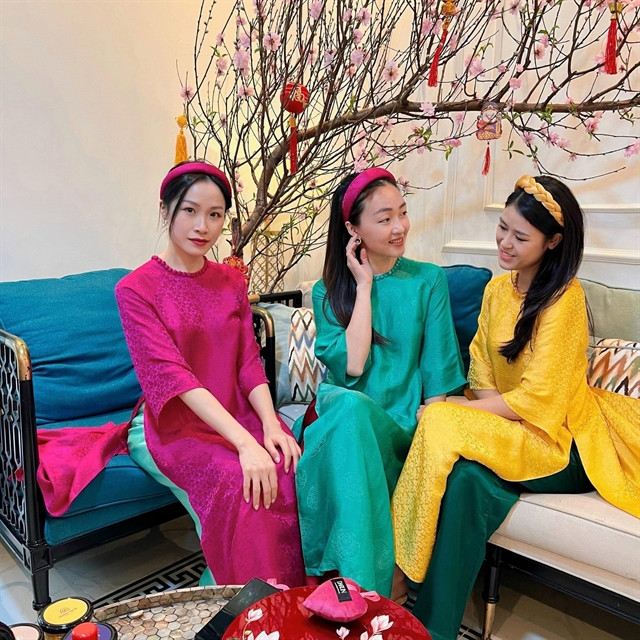 |
| Young women wearing áo dài (traditional long dress) made of Nha Xá silk. — Photo Phạm Thị Lan Hương |
Nestled next to the green fields along the banks of the Red River, Nha Xá silk cloth weaving village in Duy Tiên District of Hà Nam Province has a history of more than 700 years and the ancient craft is now being brilliantly revived.
For centuries, Nha Xá silk has been known as among the most famed silk products in Việt Nam, ranking only after Hà Đông silk in Hà Nội.
According to Phạm Văn Thực, a master artisan in the village, by the end of the 13th century, while sailing on the Red River here, Trần Khánh Dư, a high ranking mandarin of the Trần Dynasty, observed that the land was fertile, and the local people were poor, so he showed them how to grow mulberries, raise silkworms and weave silk cloth. Later Dư became the village's patron saint.
“Among other famed silk villages across the country, Nha Xá has a unique position thanks to the craftsmanship of the weavers. Our silk cloth is soft, thin and light, and rarely fades. When worn, it feels comfortable, cool in summer and warm in winter,” Thực told Việt Nam News.
“My family has four generations of silk weaving. As for me, I have more than 30 years in the profession. We do this job with all our heart, so quality must come first.”
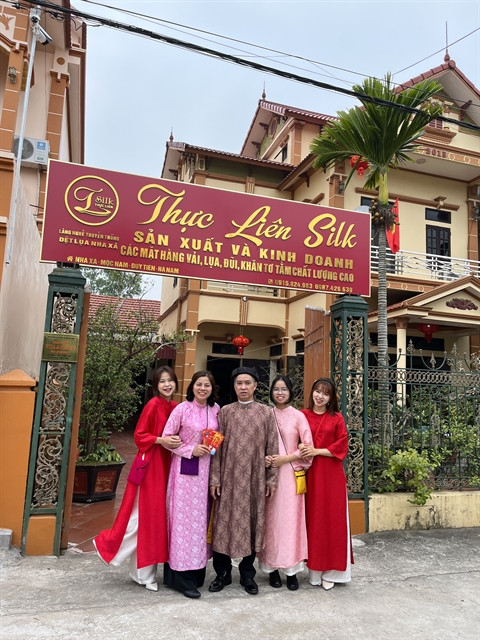 |
| Artisan Phạm Văn Thực (middle) and all members of his family have the passion for silk. — Photo Phạm Thị Lan Hương |
Nha Xá silk is made of natural silk fibres, going through a full range of processes such as spinning, weaving, dyeing and sun-drying, so the product is very durable and beautiful.
According to Nguyễn Tiến Quảng, deputy director of the Hồng Tiến Nha Xá Silk Weaving and Ecotourism Cooperative, initially, Nha Xá's textile served two purposes: to make fishing nets and bags for traders.
Through many changes, Nha Xá silk found a place in the market, becoming a much sought after cloth across Indochina. During its heyday, Nha Xá silk was sold as far away as Hong Kong.
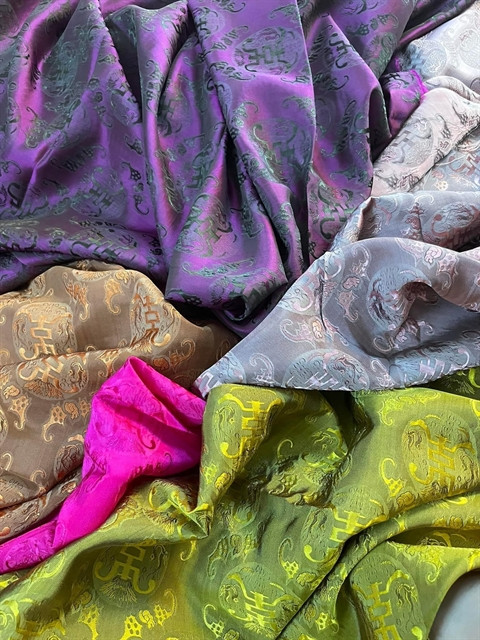 |
| Nha Xá silk is soft, thin and light and rarely fades. — Photo Phạm Thị Lan Hương |
The Nha Xá silk production process was previously a closed cycle: from growing mulberry trees, whose leaves are used as feed to raise silkworms, unwinding thread from cocoons, to weaving cloth. However, over time, the stages of growing mulberries and raising silkworms no longer exist. Instead, the villagers import raw materials from other places, and only focus on weaving silk cloth.
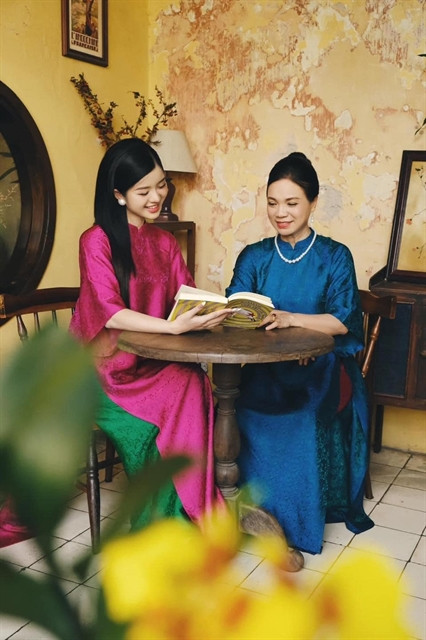 |
| Nha Xá silk is made from natural silk fibres. — Photo Phạm Thị Lan Hương |
Currently, more than 150 households in the village are engaged in weaving, with 375 weaving machines, producing more than 1 million metres of silk cloth of all kinds each year. The development of weaving has brought a prosperous and peaceful life to the village.
The Nha Xá Silk Association was established, and contributed to changing the thinking and way of doing business of the villagers. Product quality and reputation are also increasingly improved. Nha Xá is considered one of the top localities in the country in terms of silk output and product quality.
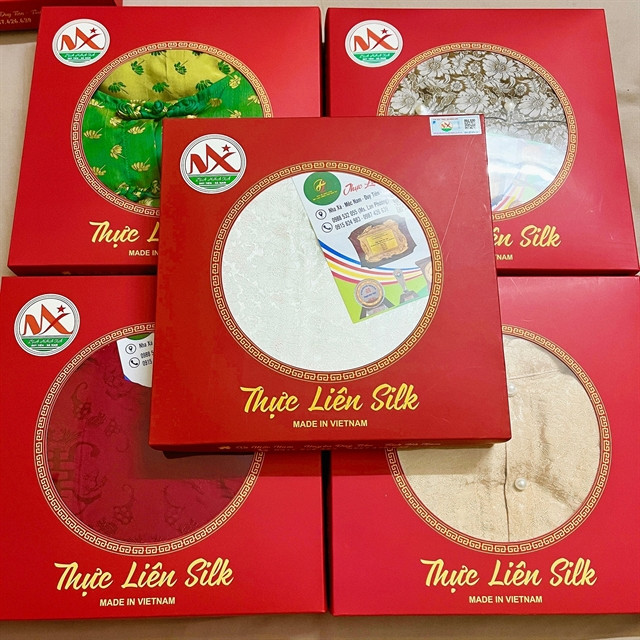 |
| Products of Thực Liên silk. — Photo Phạm Thị Lan Hương |
Nha Xá has experienced many ups and downs, especially during the pandemic. But with challenges, there are hidden opportunities, and businesses have found every way to help their products flourish and make a spectacular breakthrough in the market.
The village has taken advantage of e-commerce through websites, and social networking sites that introduce their products. Now, the village is proud to possess a large silk production capacity throughout the country, being a source of supply for many other localities such as Hội An, Đà Nẵng, Hà Nội, HCM City, Sa Pa, and Đà Lạt.
“Over the past two to three years, our silk output has not been able to meet the market demand. Every month we weave about 3,000m of silk fabric with the price from VNĐ150,000 to VNĐ400,000 per metre,” Thực said.
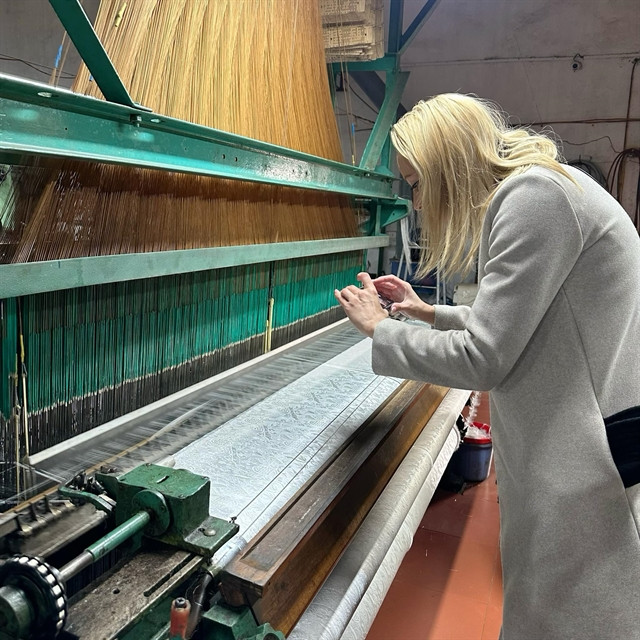 |
| A foreign visitor takes a photo of a silk weaving machine at Thực Liên silk workshop. — Photo Phạm Thị Lan Hương |
Thực owns the Liên Thực silk weaving workshop in the village. His facility is one of the few facilities in the village that can undertake all stages of weaving such as spinning, weaving, bleaching and dyeing. His workshop also makes clothes, scarves, bags, sleeping bags, and masks, attracting many domestic and foreign customers.
Thực’s wife, Phạm Thị Ngọc Liên, who is vice president of the Hồng Tiến Nha Xá Silk Weaving and Ecotourism Cooperative, is also someone who is dedicated to "keeping the fire" of the village's traditional craft.
“Even though I was not born and raised in Nha Xá, fate brought me to this profession, and I have been involved in silk weaving for nearly 30 years," Liên said.
"Since I was young, I have loved silk weaving here. Right after graduating from high school, I asked my parents to go to Nha Xá Village to learn the craft and became successful. For years, I have continued my family's traditional silk weaving profession with my love, youth, and passion.”
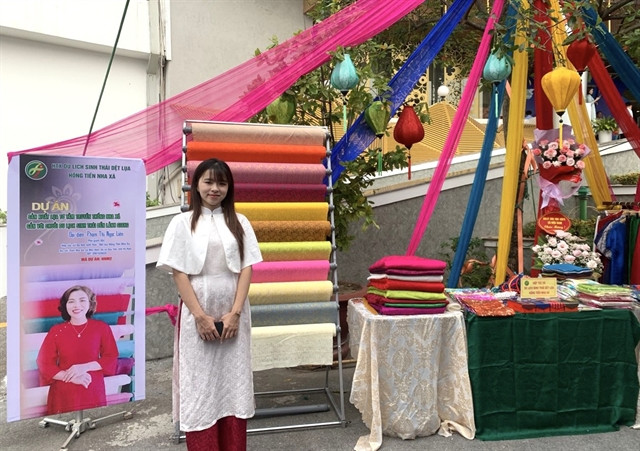 |
| Nha Xá silk weaving craft has been recognised as a national intangible cultural heritage. — Photo Phạm Thị Lan Hương |
Mai Lan, owner of an embroidery shop in Hà Nội, said: "Customers are very fond of Nha Xá silk because the fabric is completely natural. The Nha Xá silk with diverse colours and elegant patterns is the perfect fabric.”
Recently, Nha Xá silk weaving craft has been recognised as a national intangible cultural heritage by the Ministry of Culture, Sports, and Tourism. This is the motivation for Nha Xá silk village to continue to be an attractive tourist destination. VNS